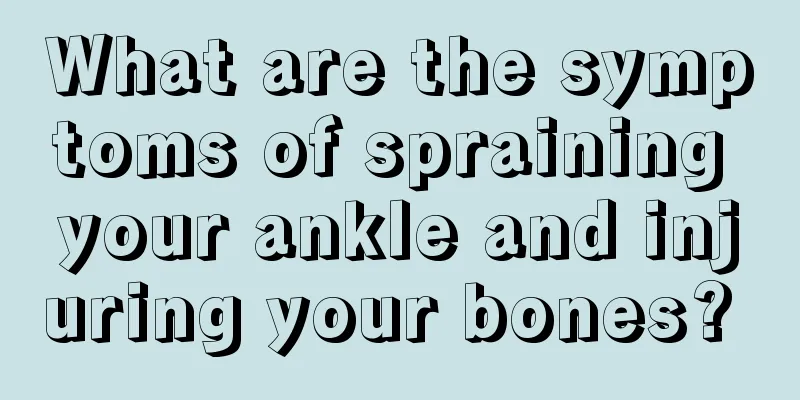What are the symptoms of spraining your ankle and injuring your bones?

|
Many friends have experienced sprained ankles during exercise because they were not careful when their feet landed. At this time, the ankle is very painful, and if the bones are injured, the pain will be more severe. If the ankle is sprained and the bones are injured, the patient will not be able to stand and will feel abnormal pain. Spraining an ankle is something that people often encounter in life, which is medically known as "ankle sprain". This type of trauma is an injury in which external force causes the foot and ankle to exceed its maximum range of motion, causing the muscles, ligaments and even joint capsules around the joint to be pulled and torn, resulting in pain, swelling and lameness. Self-diagnosis When people walk or run on an uneven road, or go downhill or downstairs, their feet may suddenly turn inward or outward, or rotate, resulting in an imbalance of gravity. In daily life, injured patients are accustomed to washing the affected area with hot water or hot towels, or rubbing the affected area with alcohol. Some people think it is a minor problem and insist on walking and working. This will not only aggravate the symptoms but also delay the treatment. After spraining your ankle, you should first determine whether it is a soft tissue sprain or a fracture. For those who have sprained their ankle, they will feel pain immediately after the injury, have limited mobility, and be unable to walk or can walk with difficulty, followed by swelling of the ankle joint. If the ankle is bruised and painful after the injury, there is obvious tenderness over the inner and outer ankles, bone friction sounds can be heard, there is functional impairment, or even deformity, then it is an ankle fracture. Identify the severity of injuries A mild ankle sprain only causes soft tissue injury, while a slightly more serious case may be a fracture of the lateral malleolus or the base of the fifth metatarsal. Even more serious cases may be bilateral ankle fractures of the medial and lateral malleolus, or even trimalleolar fractures. Mild cases can be handled by yourself, but severe cases require going to the hospital for doctor diagnosis and treatment. Therefore, it is very important to distinguish the severity of the injury. Generally speaking, if you do not feel severe pain when moving your ankle, you can still stand and walk with ease; if the pain is not in the bones but in the muscles, it is most likely a sprain and you can treat it yourself. If you feel severe pain when moving your ankle, cannot stand or move steadily, the pain is on the bone, or you feel a sound inside the foot when you sprain it, and swelling appears quickly after the injury, especially the tenderness point is on the outer ankle or the high protruding bone in the middle of the outer foot, then it is a sign of a serious injury and you should go to the hospital for diagnosis and treatment immediately. If you are unable to go to the hospital for the time being due to limited conditions, you can temporarily follow the following methods and then go to the hospital for diagnosis and treatment as soon as possible. Proper use of heat and cold Hot compress and cold compress are both physical therapies, but their effects are completely different. Blood becomes active when it is hot and coagulates when it is cold. Therefore, when the ruptured blood vessels are still bleeding, apply cold compresses to control the progression of the injury. Hot compress can be applied only after the bleeding stops to dissipate the blood stasis around the injury. Careful readers must be asking, how can we know if the bleeding has stopped? In principle, the boundary is 24 hours after the injury. You can also refer to the following points: First, the pain and swelling tend to stabilize and no longer continue to worsen; second, the feeling of swelling when raising and lowering the affected foot is not much different; third, the temperature of the skin at the injured area changes from being slightly higher than the normal part to being quite similar. These can all serve as a basis for the cessation of bleeding. |
<<: What are the methods to straighten the physiological curvature of the cervical spine?
>>: How to correct cervical kyphosis?
Recommend
Is walking like limping hereditary?
Not everyone walks beautifully. Some people may h...
How to massage comfortably, do you know these 5 massage methods
Massage has many effective effects on our body. I...
What are the symptoms of primary liver cancer? Primary liver cancer often has these symptoms
The harmfulness of primary liver cancer cannot be...
What are the wonderful uses of expired folic acid?
It is very necessary for people who want to get p...
Accurate tapping of the lung meridian has good results
The lung meridian plays a key role in the human b...
What is the use of nasopharyngeal carcinoma metastatic nuclide and how to treat nasopharyngeal carcinoma
What is the use of radionuclides for nasopharynge...
What are the benefits of soaking your feet in rice vinegar
Although white rice vinegar can kill fungi and ca...
Can black soapberry seeds help increase milk production?
The living environment of modern women is very su...
Should I take CT or X-ray for a fracture
After a fracture occurs, first aid measures shoul...
The clinical treatment knowledge of nasopharyngeal carcinoma needs to be always understood
Nasopharyngeal carcinoma is a disease that seriou...
Analysis of colon cancer metastasis sites
The common feature of cancer is metastasis in the...
Is there formaldehyde in mahjong seats?
Mahjong mats are a kind of cool mat that many peo...
How can we educate our children well?
During the pregnancy process, parents hope that t...
Can swimming treat high blood pressure?
People now have a higher standard of living and e...
What to do with clothes after a bone scan
We know that bone scan is the common name for &qu...









